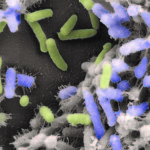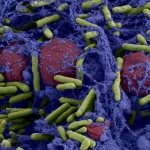Lien DOI – 10.1071/EN19190
Environmental Chemistry 17(1) 39-53 https://doi.org/10.1071/EN19190
The release of engineered nanoparticles (NPs) to the environment may have profound implications for the health of aquatic biota. In this study, we show that the initial stage of the action of NPs on bacteria can be detected by the measurement of the electrophoretic fingerprints of mixed NP–cell dispersions. Such electrokinetic signatures reflect a modification of the physicochemical surface properties of both cells and NPs following changes in the organisation of the cell envelope, subsequent release of intracellular material and/or excretion of biomolecules. The demonstration is based on a thorough investigation of the electrohydrodynamic features of genetically engineered Escherichia coli bacteria with distinct surface phenotypes (presence of adhesive YeeJ large proteins or F-pili proteinaceous filaments) exposed to silica NPs (radius of 65 nm) functionalised by -NH2 terminal groups. At pH 7, electrostatics prevents interactions between bacteria and SiNH2 NPs, regardless of the considered concentration of NPs (range of 0–10−2 g L−1). At pH 3, electrostatically-driven interactions allow intimate contacts between NPs and bacteria. In turn, significant modulation of the electrophoretic determinants of cells and NPs are generated owing to the alteration of the cell envelope and acquisition of bio-corona by NPs. Differentiated roles of the cell surface appendages in the mediation of NP impacts are evidenced by the measured dependence of the electropherograms on cell surface phenotype and NP concentration. Cell morphology and surface roughness, evaluated by atomic force microscopy (AFM) in liquid, confirm the conditions of pH and concentration of NPs where NP–cell interactions are operational. The combination of electrokinetics and AFM further pinpoints heterogeneities in the cell response at the single cell and population scales. Altogether, the results show that electrophoresis is suitable to detect the preliminary stage of events leading to the toxicity of NPs towards microorganisms.


